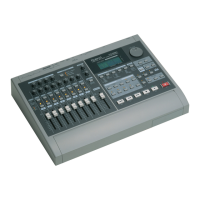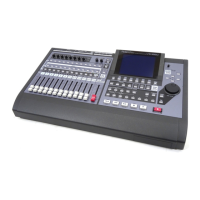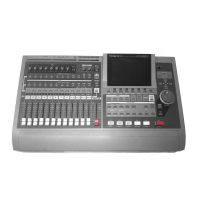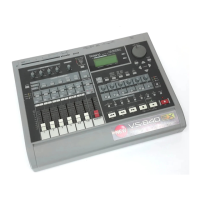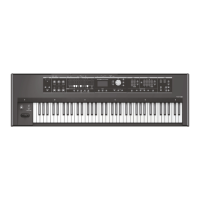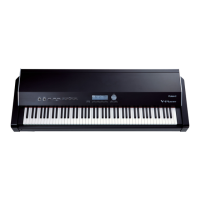25—Harmony
332 www.Roland.com Roland VS-2000 Owner’s Manual
Using the TRACK/STATUS Buttons
When Harmony is turned on, you can use the TRACK/STATUS buttons to enter the
desired Harmony notes. Beneath each buttons is a label that shows the button’s role in
Harmony creation. The behavior of the buttons depends on the setting of the INPUT
MODE parameter (Page 337), which can be set to NOTE or Chrd mode.
The TRACK/STATUS Buttons in NOTE Mode
TRACK/STATUS button #: Harmony Name: What it Does:
1 and 2 -Oct. and + Oct. These two buttons work together.
When they’re both unlit, the TRACK/
STATUS buttons select notes in the
octave above Middle C. To change
octaves, press either button to turn it
on, shifting the pitch in the direction
of the lit button. To return to the
original octave, press the unlit button
so both buttons are unlit.
3Port. This button turns portamento on (lit)
or off (unlit) by changing the value of
the PORTAMENTO parameter—see
Page 330.
4 Legato When Legato is lit, the last-entered
harmony continues sounding until
another harmony note is entered.
5C When both Oct buttons are lit, press
C to create a note at Middle C, or C4
in MIDI terms. Otherwise, the button
plays a C in the selected octave.
6D When both Oct buttons are lit, press
D to create a D harmony note above
Middle C, or D4. Otherwise, the
button plays a D in the selected
octave.
7E When both Oct buttons are lit, press
E to create an E harmony note above
Middle C, or E4. Otherwise, the
button plays an E in the selected
octave.
8F When both Oct buttons are lit, press
F to create an F harmony note above
Middle C, or F4. Otherwise, the
button plays an F in the selected
octave.
VS2000OMUS.book 332 ページ 2004年10月20日 水曜日 午後3時3分

